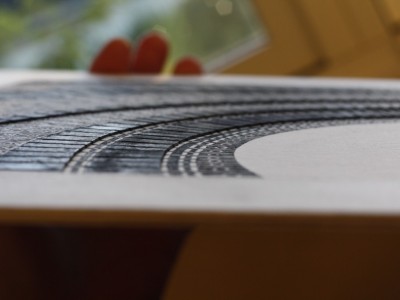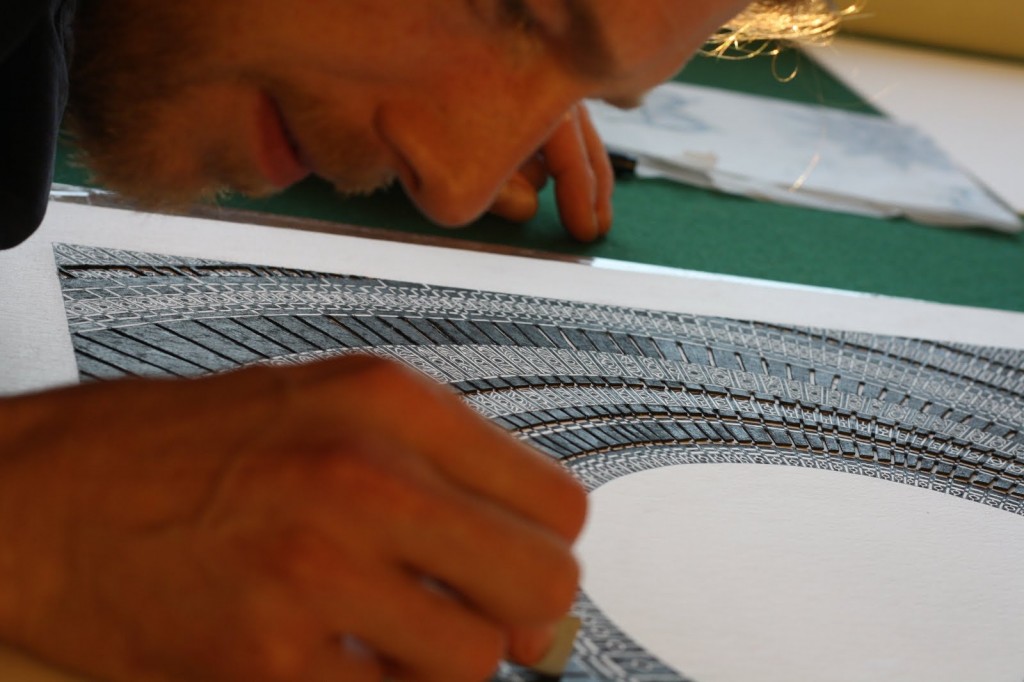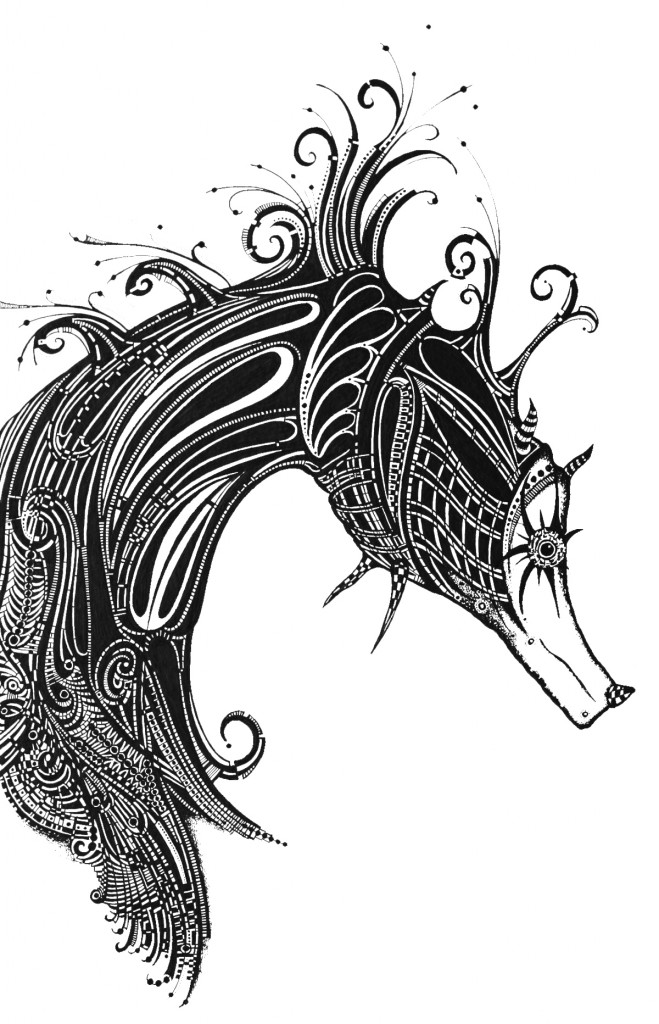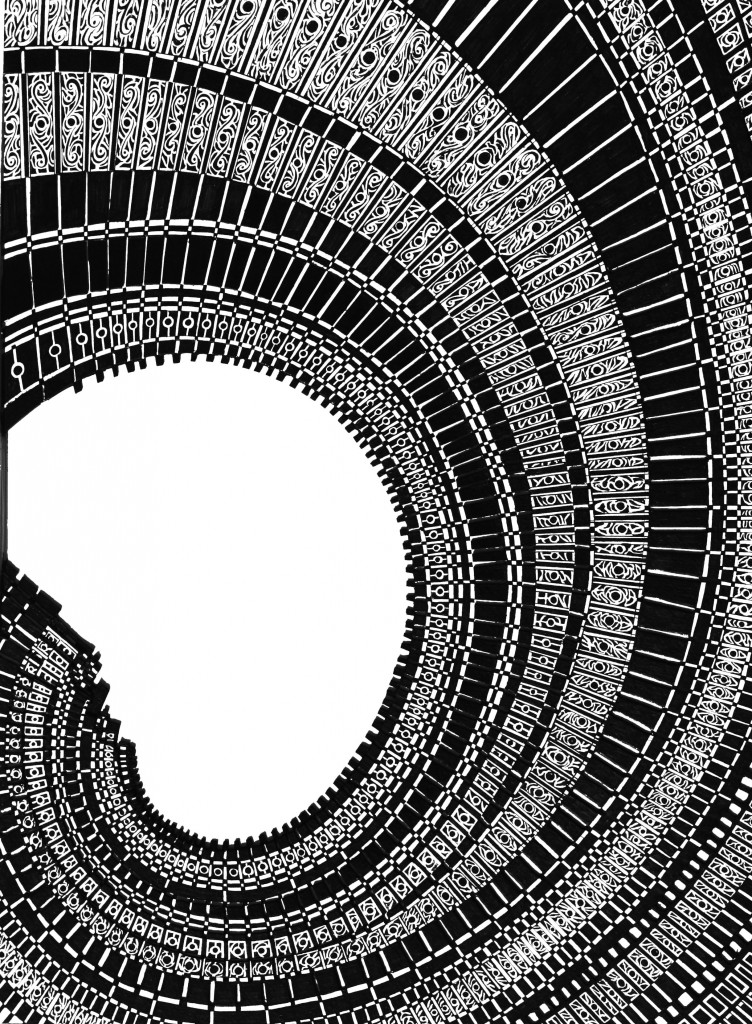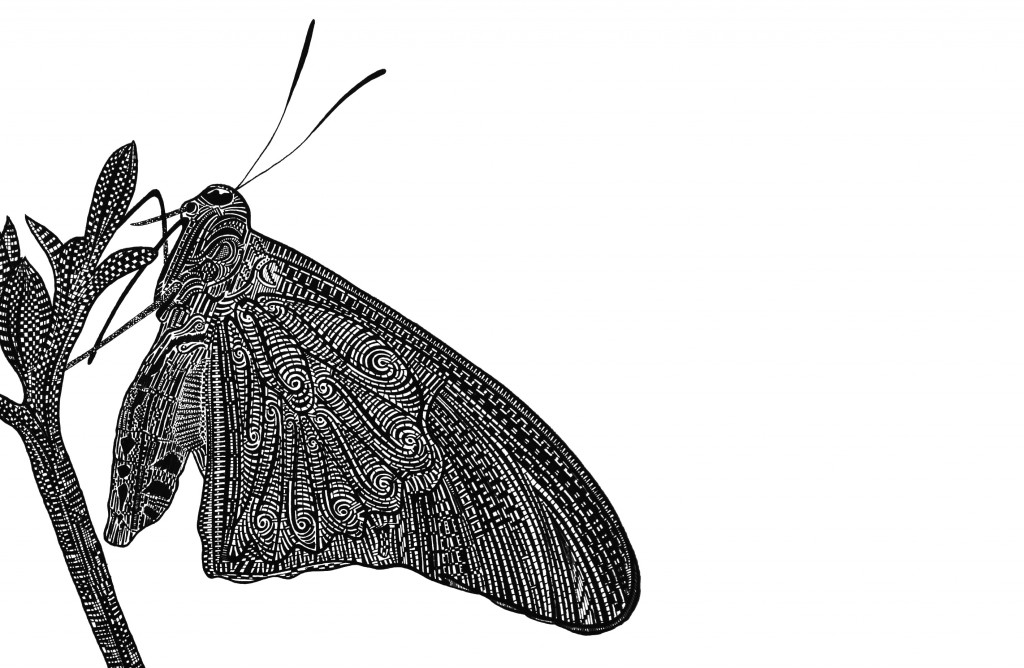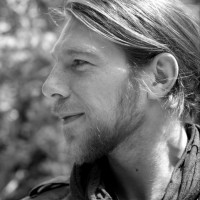We’re very interested in knowing about your artistic experiences as a child and as a teen.
As far back as I can remember I was always interested in drawing and painting. I come from a family with four kids and our mother encouraged us to express ourselves artistically. Pencils and painting utensils were always close to hand at home. As a child I was fascinated with birds and would spend my time copying pictures from books trying to recreate what I saw. When I grew older I became more interested in abstract representation and would spend my time in school adorning all my copy books with geometric lines and spirals. I spent more time using my compass and protractor to create patterns than for actual geometry.
How long have you had ink as your principal artistic medium?
Since leaving school I’ve used ink as my principal artistic medium. I’m constantly experimenting with different mediums but I always come back to ink for my main body of work. Like any medium it takes a lot of time and practice to become comfortable with its process and personality. When I was younger I used to make a lot of mistakes which is not good when working with ink. Painting or pencil drawing can be easily covered up or erased. I had to throw out a lot of works because of one bad move with the pen. Over the years and with time and practice mistakes are less frequent. I think my process has benefited with age. When I was younger I was a bit more reckless with the pen. I would literally have an idea and immediately dive into getting it on paper straight away. These days I’m more contemplative. I’ll have an idea and rather than jump straight in I like to plan and think about what exactly it is I’m trying to achieve with the work. I’ve just finished a Masters degree in Music and Media Technologies in Trinity College Dublin. The two years of writing reports has made me really analyse what it is that I’m trying to achieve. These days I do a lot more sketching with pencil before executing a piece. One of the worst feelings is realising that you’ve made a mistake and lost 30 hours of work, so planning these days can consume as much time as the execution of the work.
What informs your designs? Personal/experiental mental images, patterns/motifs from traditional cultures (like the Maori), other artists, even…mathematics?
My main source of inspiration is definitely nature and has been since I started drawing. The silhouette or outline of a form is hugely important to me and, although my work seems to concentrate on the minutia, the overriding structure of the work is the key aesthetic factor for me. When I’m working in black and white I contemplate an image differently than say when I’m working with color. In a way, black and white as a medium is much more restrictive. Certain techniques like perspective are harder to achieve but, conversely, working in monochrome can have such a visual impact that it is worth the compromise. Part of the adventure for me is experimenting and finding these new patterns and new ways of working within the black and white process. I’m always finding inspiration for new works in nature, whether it be in the rings of a tree, a shell or a spider web. All I have to do is look to nature and the patterns are there.
Part of my fascination for these visual patterns stems from being a composer and a musician. As a composer I work with musical patterns all the time and am becoming increasingly fascinated between the connections between music and art. At first, one might wonder about what the connections between the two are, but on closer analysis music and art have a lot in common. Structure, harmony, consonance and dissonance are all factors that both music and art have in common. As part of my final Masters thesis work I got to explore all the connections between the two. The work, titled Impressions de la Mer, consists of three movements: the first movement is the musical element; the second movement is the artwork and; the third movement brings together the artwork and the music in an audio-visual composition.
Another idea that I got to explore within the project was the concept of the Golden Ratio. The Golden Ratio is basically all about maths and geometry. The fascination for me lies in the fact that the ratio keeps appearing in nature. Only the other day I was out enjoying the two days of sunshine that is the Irish summer and whilst sitting on grass I picked a daisy and started investigating the construction of it. The individual florets of the daisy grow in two spirals extending out from the center and these spirals are in the Golden Ratio. It is fascinating to me to think that the numbers and ratios that create the design of the flower are the same numbers that are present in the design of a pinecone, a shell or in the arc of sea wave.Have fans of your work ever expressed a longing to use your designs as a basis for skin art? How do you imagine it would go over, in terms of detail and effect?
When I was getting started as an artist I was still unsure about what way I wanted to progress and I looked into becoming a tattoo artist myself. There are lots of really talented tattoo artists in Dublin so I got my portfolio together and decided to go into one of the shops and have a chat with some of the artists. That has to be about 14 years ago; anyway the chat was so insightful that I decided there and then that tattooing wasn’t for me. The artist explained to me that you have to be willing to draw everything and anything; I told the guy I wasn’t and that was the end of the conversation. I’ve had quite few people approach me about designing tattoos but I’ve always declined. I think while the concepts are similar the media are so different. People want different things from a tattoo then they want from a piece of work to hang on their wall. I have a lot of respect for tattoo artists because in a way their job is more challenging. Rendering a 2D form onto a 3D curved surface is much harder than say rendering onto a flat piece of paper.
Your drawing “The Moon” is so mesmerizing. We’re curious how long it took you to design, draw, and finish. Do you work in certain stages? How many hours or days or sittings did “The Moon” require before it was completed?
Thanks so much, I also found it mesmerizing whilst I was drawing it. I literally lost hours with that piece. When I’m working on pieces I forget about everything else, food, sleep, everything. I’ll work for 16 or 18 straight no problem. I think The Moon took about 50 in total to complete and I did the piece in four sessions over the course of a week. By the end of a work my eyes and body are exhausted so I try to give myself a bit of a break before starting a new piece. The Moon is still one of my favorites; I sold it about two years ago and to my knowledge it resides on the other side of the globe in Sydney, Australia. I love to think of one of pieces living on a wall on the other side of the globe.
Are you familiar with others in Ireland who work with ink on cartridge paper?
To be honest, not really. I haven’t seen many people working with the medium in contemporary art but if you go back a bit into Irish history some of the most famous Irish artists worked with ink. One of my favorite Irish artists is Harry Clarke. He is well known for his stained glass pieces but I love his ink illustrations. They are gothic and magical and really quite dark. These illustrations can be considered the polar opposite of the work that I’m executing. Clarke’s ink works move from dark to light with predominantly black areas, whereas my works contains large areas of white with the black used to create the detail. Some of my favorite images of Clarke’s are his illustrations of Edgar Allan Poe’s The Pit and the Pendulum.
Would you say that this is an Irish art form by nature?
I did once have an older gentleman tell me that I must have some ancient Irish monk in me. The ancient monks used to work on manuscripts for days on end and if a mistake was made the whole script would be started again. I guess in a way they were striving for perfection in an effort to be closer to God. Whilst I don’t believe that the work brings me closer to a divine being, I do agree that you have to have a lot of patience to do the work I do. One thing time has taught me is that ink drawings cannot be rushed. They take as long as they take.
What new exhibitions have you been working on?
I’m currently working towards two exhibitions. The first is titled Chaos & Order and features twenty ink drawings. The pieces are from the last three years of my career and will document how I’ve developed my personal technique over this time. For example, some later pieces such as Shell are made up of multiple layers of inked and cut paper to give a 3D quality to the work. The second exhibition continues on the work of my Masters thesis project. I’m aiming for the start of next year for it to be ready. The exhibition will feature ten works of art. Each artwork will be based on a piece of music that I wrote. The exhibition will also feature ten audio-visual compositions that will forge the connections between the audio and visual element. I’m excited and nervous about both exhibitions but in particular the second one. There is a lot of work yet to be done for it but it’s a new venture for me and will allow me to bring together my two great loves of life, music and art. I think as exhibitions go the fact that this one will have art, music and video combined should make for a very interesting event.
Where would you like to see your work exhibited in the future?
That’s a difficult question because I was lucky enough to hold my last three exhibitions in an amazing property in Dublin city centre called Number 10 Ormond Quay and it is hard to imagine a more beautiful space. The property is owned by John Lynch who can only be described as a modern day Medici when it comes to supporting the arts. Four years ago I was invited to an exhibiton held at Number 10 and upon entering the building immediately fell in love with the place. The property is an old Georgian house that John has restored to an immaculate condition. He has adorned the walls with a beautiful collection of works of art. One just has to walk around the property to be inspired. About a week after attending the first exhibition I approached John with my portfolio and an idea for an exhibition of my work, and the rest is history. I’ll be exhibiting at Number 10 again this summer with Chaos & Order. In the future I would like the opportunity to bring my audiovisual exhibition to Paris. The inspiration for this exhibition comes directly from the Impressionist painters and composers who were at the very heart of Paris in the late 19th century. Long term, I’d like to think that there was a way of bringing the exhibition to concert halls and witness a complete crossing over of the art forms.
View “Impressions De La Mer” by artist/composer Anthony Wigglesworth:

